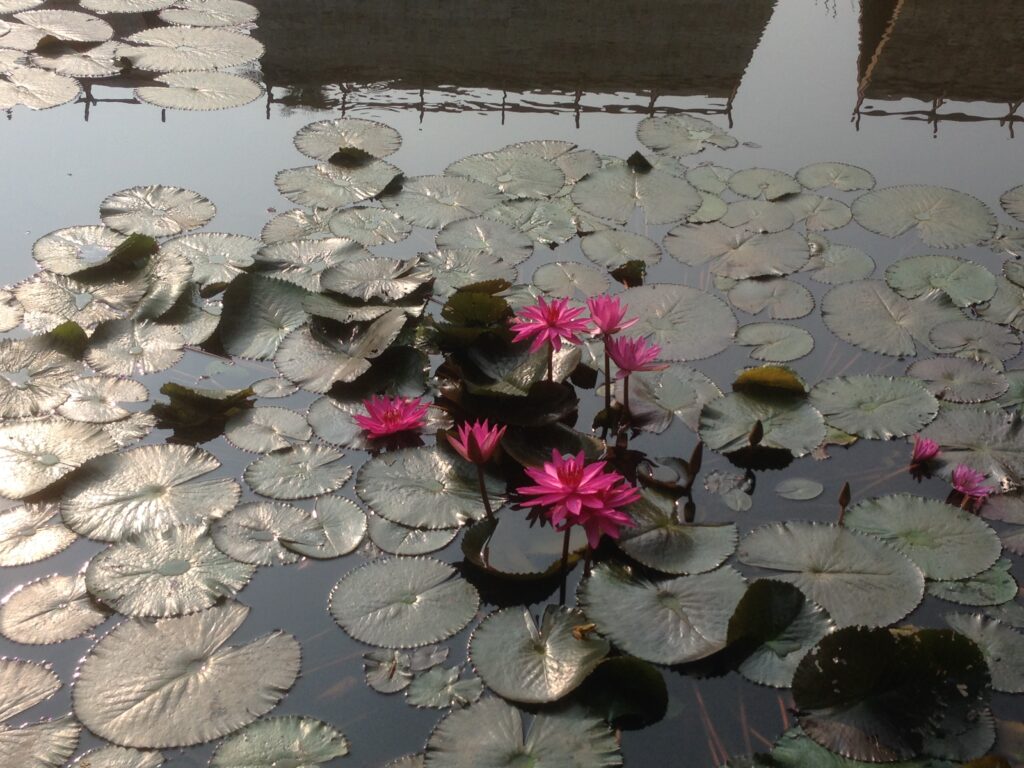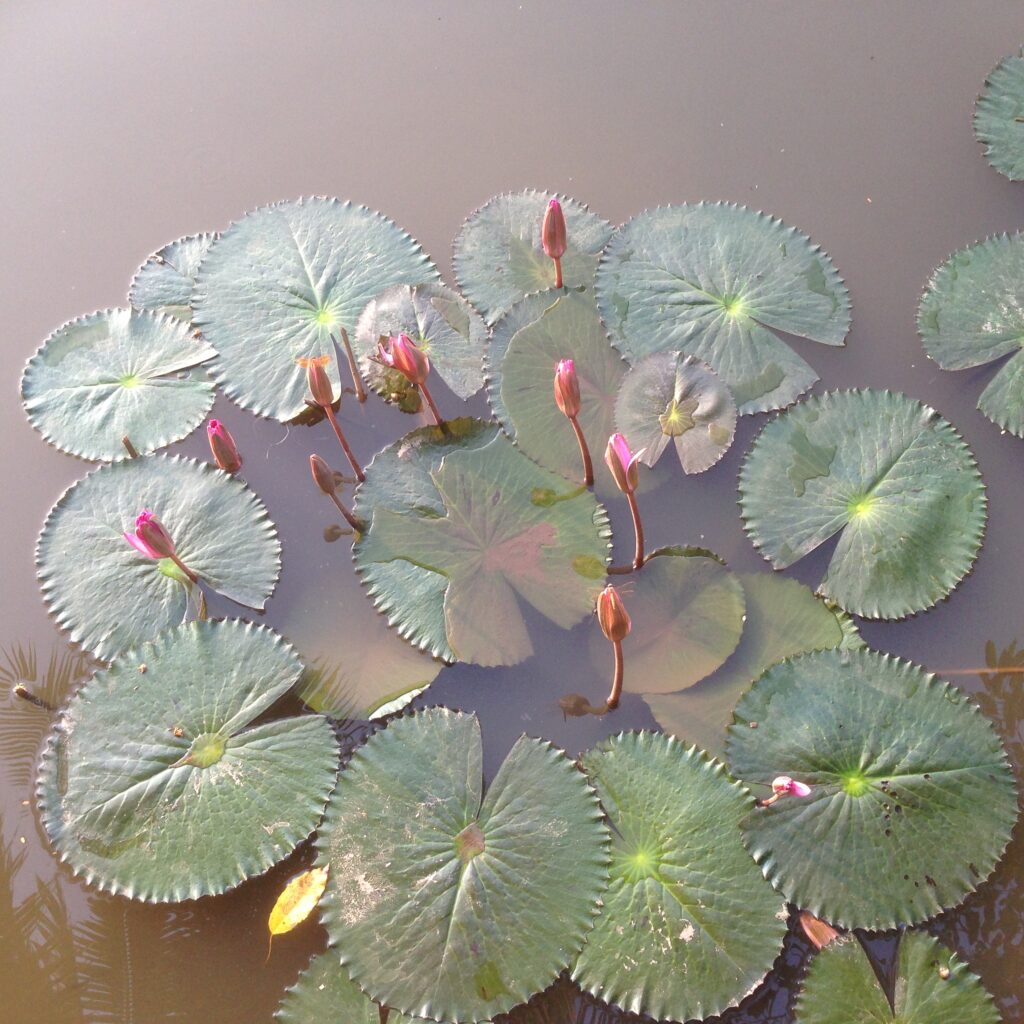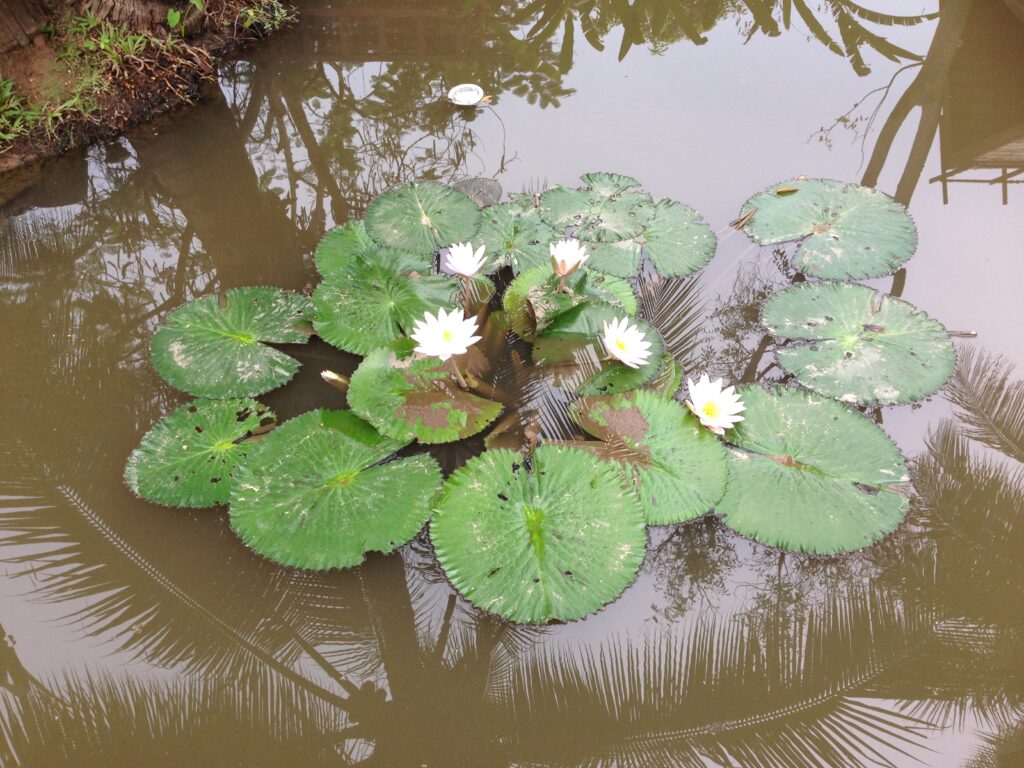Believe it or not, we all want to heal from traumas and their physical manifestations, which often manifest as pain. What else can help you recover other than a Lotus flower?
The lotus flower stands at the top of our logo, and one might ask why we attach so much importance to it. We believe the question is legitimate and warrants an answer.
Since we specialise in the Asiatic Thai Massage business, we’ve included the Lotus in our logo to emphasise its significance. It’s also because the lotus flower is revered and respected in Thai culture and religion.
Special thanks to Tao Chi Kai for producing this video.
Thai massage, particularly Traditional Thai Massage, has had a significant influence on Buddhism. In Buddhism, the lotus flower is often regarded as a symbol of Purity and Enlightenment. The article below explains the importance of the lotus flower.
It’s the flower that holds the real delicacy and strength to claim its healing power to help you improve your condition that you might have been fighting with over an extended period! What else can be such a trustworthy flower other than the LOTUS?
This is why healing brands have been using the flower for medicinal purposes. Can it also help you regain the vitality of life, allowing you to enjoy every moment you breathe in?
The good news is, yes! No matter your culture, nature’s beautiful gift has proven its deepest roots in holistic health practices.
It’s not the story of centuries, but thousands of years, when human eyes first caught sight of this inviting flower smiling upright amid dark, muddy water, with its open arms, ready to embrace and flourish human existence.
Indeed, the man had apprehended that it was what he had been searching for and began affirming the holiness of this blooming charm either at the altars, in food, or in the medicines that required hours of untiring preparations.
Then, how exactly has this LOTUS bloomed in various Asian and other cultures? Let’s explore this in our article. Maybe, by the end, you’ll also wish for the softness of LOTUS infusing peace on your limbs and muscles that you want over and over.
Why is the Lotus Flower so Unique?
The lotus plant grows at the bottom of water bodies, deep in the mud, where it receives no sunlight. But once it matures and reaches the light, the plant blooms into spectacular, stunning, and mesmerising lotus flowers.
In many cultures, the lotus flower symbolises purity, enlightenment, self-renewal, and rebirth, especially in Eastern religions. It can take root in dirty water and still produce the most beautiful flower, perfectly representing the human condition.
Lotus is an aquatic plant characterised by its broad, floating leaves and bright, scent-filled flowers. The stems are long and contain air spaces. The flower consists of many petals that are symmetrically stacked on top of each other.
The work of the root stalks spread horizontally through the mud below the water surface. The round leaves can grow up to 50 cm in diameter. The flowers are pink, like roses, with a slightly white shade, and the hard seeds are dark brown.
The shape of the sources varies from round to elliptical to oblong. The lotus flower blooms at sunrise, and the petals disperse in the afternoon.
Lotus propagates mainly by seed. It grows in moist soil and requires at least 6 hours of sunlight per day. Lotus plants also need to be fertilised regularly for at least one year. Protecting the Lotus from freezing is essential. Additionally, it requires adequate lighting.

The Lotus Flower’s Evolution over Millions of Years
The mystery of the lotus flower lies in its status as a living fossil. Its history dates back to about 145.5 million years, and it survived the Ice Age (1.8 million to 10,000 years ago).
It was an era of significant geological and ecological change, during which most plants in the northern hemisphere went extinct.
This plant survived that period because of its exceptional longevity—indeed, it bestows the same on you. The flower also grows wild in Russia, Australia, the Philippines, China, and Iran, and it seems to survive in any extreme climate.
The Egyptian Lotus is believed to have been introduced to Egypt from India in the 6th century B.C. via the East-West trade route; however, some scholars suggest it originated in Iran. It thrived on the banks of the Nile, and later, the ancient Greeks, Phoenicians, and Romans cultivated it.
These facts add to the symbolism of the Lotus in cultures and religions throughout history.
Lotus and Its Interpretation in Major Religions
It’s common to observe the lotus’ prominence in Asia. Not only therapeutically, but socially and religiously.
The Lotus is a part of almost every religion in Asia, and its unique meaning permeates the lives of nearly every country and its people.
Let’s see how this beautiful flower emphasises its importance.
Buddhism is a major admirer of the Lotus.
It’s part of the Buddhist belief system that all people have the potential to achieve enlightenment, and it’s only a matter of time before each human being begins to seek and discover the absolute truth. Buddhists believe it is necessary to undergo reincarnation to refine one’s being until one reaches nirvana, the ultimate state of awareness that a human can achieve.
For this reason, we find countless depictions of Buddha sitting on a lotus flower or his seat having lotus petals carved into it. Like the lotus flower, which begins to grow in muddy, polluted water and blossoms into a perfect flower, these depictions represent an enlightened being who has overcome the suffering that pervades the material world. It’s also not uncommon to find many Hindu gods depicted sitting or standing on the lotus flower.
Lotus is the birthplace of Buddha.
Most of Buddha’s teachings originate in the Lotus Sutra (Lotus of the True Dharma), where the sacred lotus flower signifies the essence of Buddhism. Buddhists also believe that the Buddha was born on a lotus leaf.
Spiritual enlightenment in Buddhism through the Lotus
Buddhism believes this pure flower brings a smile to anyone who sees it.
Buddhism teaches that, like the lotus flower, we should be a source of happiness and delight for others, making their lives meaningful and beautiful, regardless of the difficulties or adverse circumstances that surround us.
Additionally, in Buddhism, the colour of each flower holds a distinct meaning. For example, the white Lotus is also part of the Four Noble Truths and represents mental righteousness and perfection from within, which is a spiritual concept.
Can you relate the eightfold path from Buddha’s teachings to the eight pearls of the White Lotus? You should do so because Buddha’s birth spot also connects with the eightfold path.
Just as the rose is significant for love and emotional refinement, the red Lotus represents a pure heart. The characters for compassion, ardour, and love encode their nature.
The blue Lotus is a sign of triumph; it connotes a win over the senses. It also stands for truth and wisdom. The magnificent pink Lotus represents the Buddha and his teachings.

The magical effects of the Lotus in the Buddha Mantra
The Buddha’s mantra, “Om mani Padme hum,” carries a rich, mysterious, sacred, and profoundly spiritual meaning. In this mantra, the word “Padme” means “locus.” The mantra is often referred to as “the jewel in the lotus.” It translates to “praise to the jewel in the lotus,” describing the oneness and fraternity of all beings and the divine potential within.
Lotus in the Buddha art
In Asian art, the lotus throne or lotus platform refers to a stylised lotus flower that forms the base or seat of the statue. (In Buddhist, Hindu, and Jain art, it is the usual pedestal for statues of deities.)
The Holiness of the Lotus in Hinduism
Another major religion on our planet, Hinduism, also affirms the holiness of the Lotus. Here is how you can see it blooming in every Hindu’s life.
Lotus is the seat of the gods.
The Lotus, a sacred icon in Hinduism and Indian culture, is mentioned in numerous descriptions throughout almost all Hindu holy scriptures. The universe’s chief creator, Lord Brahma, and another lord, Vishnu, the preserver, are each depicted as sitting or floating on a lotus.
Lotus is the birthplace and origin of the God Brahma.
Hinduism believes Lord Brahma was born from a lotus flower from Lord Vishnu’s navel.
Hinduism has noted several similarities between the bodies of Lord Krishna and Lord Vishnu. They believe the former’s body originated from Lord Vishnu’s, as he was bluish like a lotus flower.
Links to Brahma and Lakshmi
Many Hindu scriptures also associate the lotus flower with other gods and goddesses, especially Lakshmi, the Goddess of prosperity, who is often depicted floating above a fully open lotus flower in Hindu art.
In Hinduism, the lotus flower is particularly associated with the God Brahma, and the Goddess Lakshmi is a symbol of beauty, health, abundance, fortune, and eternity. Most primary rituals centring on Goddess Lakshmi also feature the Lotus flower.
The Lotus Flower is the centre of attraction in Indian art
Plankartha, one of the eight grand symbols of Indian classical art, which seems to illustrate the Lotus: buds, flowers, and leaves, is also considered an embodiment of ingenuity and creativity. This lotus motif is vital to India’s Taj Mahal heritage site.
Several ancient Hindu scriptures also describe Lord Krishna as a god with a Lotus Eye. Hence, the lotus flower is prominent in various scriptures or doctrines.
According to the Hindu scriptures, the Upanishads, the Lotus represents profound contemplation and introspection. The Upanishads also believe that the supreme inner self of man, the Atma, resides within the lotus heart (often depicted as the heart enclosing the lotus flower, a symbol of purity).
Lotus as a metaphor for the heart
Hindus use this flower to offer to God. As a symbol of attachment and devotion, known as “Bhakti,” this offering emphasises that their love for God should remain pure despite being busy with worldly affairs, as the muddy water does not influence the lotus’ purity and beauty.
A true devotee can turn his heart towards God, who exists nowhere else but in his heart. Although God exists everywhere, in human beings, God appears as Param Atma, or the transcendent soul, in the heart, which is the spiritual centre. Therefore, finding God in temples is useless, as it is the devotee’s heart where the Param Atma resides.
The Maha Narayana Upanishad also explains the same idea: “Within the citadel of the body is the small, sinless, pure lotus of the heart, the residence of the Supreme.” In Hinduism, the lotus flower represents an individual’s heart.

Eastern poets, philosophers, sages, saints, masters, intellects, gurus, and historians have likened the lotus flower to the holy feet of gods and other heavenly beings.
Egyptian Mythology and the Holy Lotus
Ancient Egypt was the earliest civilisation to worship the lotus flower, symbolising fertility, birth, purity, and many other things. It is also believed to have a close association with the dead.
According to the Egyptian Book of the Dead, a dead person could be transformed into a lotus by a magic spell or talisman. The book referred to the lotus flower as an emblem of resurrection and rebirth.
The Lotus is often visible in Egyptian art and architecture, especially in temples. In the Lotus Sutras, the Sun god is believed to have emerged from a floating lotus. In the spiritual teachings of ancient Egyptian literature, the Lotus is referred to as “Seshen.”
Lotusnifies the sun, which in turn implies creation and rebirth. At night, the lotus flower closes its petals and dives to rest in the water. The following day, when the sun shines, the lotus flower rises and opens its petals, suggesting that the Lotus is born by the sun.
Blue lotuses have religious significance. The Egyptians believed the blue Lotus had a rich fragrance and a narcotic-like power to raise consciousness and bring peace.
Lotus’ Importance and Interpretation in Christianity
The Lotus is also depicted in the Lotusography of the Christian churches in Greece and Rome. In the Annunciation painting, the Archangel Gabriel appears before the Virgin Mary, the mother of Jesus. In these paintings, Gabriel is always seen holding a water lily flower.
Unlike ancient religions, Christianity emphasises meaningfulness, which is why you can find many positive interpretations of the Lotus in Christian contexts.
Lilies and lotuses symbolise abstract ideas such as purity, fertility, and mental, spiritual, and physical purification. Since they emphasise positivity, they’re a part of many Christians’ everyday lives through various decorations and ornaments.
Lilies and lotuses symbolise abstract ideas such as purity, fertility, and mental, spiritual, and physical purification. Since they emphasise positivity, they’re a part of many Christians’ everyday lives through various decorations and ornaments.
If you dream of a sacred lotus flower, you are marked by fate as a person of an extraordinary destiny. It symbolically reflects the magical abilities and hidden talents that must be developed.
Have you ever seen strange flowers in your dreams? Then, the most favourable time to develop your creative potential arrives.
The lotus flower represents a spiritual awakening, where opposing principles degenerate into something beautiful and bright. This flower predicts that you will do something sagacious.
What else does this sacred plant mean in a dream? The dream’s interpretation is specific, and given its characteristics, the images must be interpreted accordingly. This includes conditions, colours, and positions.
What else does this sacred plant mean in a dream? The dream’s interpretation is specific, and given its characteristics in the dream, the images must be interpreted. This includes conditions, colours, and positions.
Painting on a cloth is a sign of good luck in business.

- On the wall – knowledge
- On the body – profit
- The Red Lotus advises against trusting gossip.
- The yellow Lotus represents friendship.
- White Lotus is a symbol of purity, Lotus thought.
- The black Lotus implies negativity in Lotus manifestation.
Interpretation of the Lotus in Islam
The recognition of Lotus is not as remarkable in iLotusam as in other religions. Yet, it has immense importance as an indication of growth, profit, and well-being, and it’s why many scholars have praised it if you see it in your dream.
- You can hope to have a pious life partner from a noble family.
- You might get riches from fair means.
You can hope to gain insight into the meaning of the lotus flower and its fruit.
For instance, if you see yourself eating lotus fruit, you might be recognised in religion or society.
Hence, although not metaphorically, the lotus flower still holds great favour in Islam. Still, in many Asian Islamic countries, the Lotus is a different flower.
Lotus Flower as a Symbol of Perseverance, Freedom, and Development
The lotus flower signifies the pure nature of the spirit. No matter how dirty the water is, the plant has survived and can still produce pure and enticing petals.
The flower also symbolises freedom. For instance, when you pour water on a lotus flower, the water drops will not have room to stay over the leaves but roll off.
The lotus flower is also a sign of “svayambhu,” meaning self-renewal in Sanskrit. Considered one of the most aesthetic water lilies, it is a noble and spiritual flower in many religions and cultures worldwide.
This epitome of noetic procreation represents the birth of God, spiritual advancement, and even creation itself.
The lotus bud symbolises the hidden potential of spiritual essence and an individual’s mind, much like a lotus flower. As the lotus flower undergoes the initial stages of growth in the turbid water and then blooms into a beautiful flower, human intellect also goes through a similar stage to reach enlightenment.
The lotus flower also explains the chakra system. The crown chakra is associated with a lotus with a thousand petals, and its flowering signifies enlightenment.
Lotus as a Lesson of Detachment
The Lotus is an analogy for a spiritually enlightened person who carries out his work without concern for evaluation and is entirely free from attachment. The bloomed lotus flower and the unopened Lotus bud are perfect analogies for the human soul, with its ability to expand toward divine truth.
The Lotus also illustrates how to grow spiritually without being affected by the evil influences around us. Bhagavad Gita, one of the sacred books of Hinduism, reads: “Just as a lotus leaf is not immersed in water, so he who fulfils his duty without attachment and submits the result to the Supreme Being is not affected by sinful actions.”
Before we discuss the lotus flower and its relation to Asiatic Thai massage, let’s first understand a few basic things about the Lotus in various cultures and solitude, especially in Asia.

Lotus Flower Meaning in Every Culture
Lotus Flower in Chinese Culture
It is a part of religious and social ceremonies. They live with it and eat it.
In Chinese poetry, the stalk of the lotus flower is compared to a friend or family member. It’s because the lotus stem is bendable, yet it’s hard to break.
For the Chinese, the Lotus is a symbol:
- A man who licks out of the swamp but is not contaminated.
- Empty inside, upright outside.
- Purity
- The lotus’ fruit, flower, and stem are equal to past, present, and future.
Famous images and sayings about the Lotus in China illustrate this point.
- The lotus flower, with its leaves and buds, represents a complete union.
- A magpie sits on the stamens of a blooming lotus flower and collects seeds. May you have the pleasure of passing one test after another.
- If you receive a photo of a boy and a carp next to a lotus flower, you may live abundantly year after year.
- Two lotus flowers or a stem consisting of a lotus flower and a single flower represent the hope of a united heart and harmony, representing the union.
- The Lotus (symbolising a girl) and the lionfish (symbolising a boy) signify love.
- Courtesans were often referred to as “red lotuses.”
- The bluestem of the lotus flower symbolises purity and modesty.
The Lotus also has excellent value in botulism. One of Tao’s Eight Immortals is Ho Shen Ku, and her symbol is an open lotus flower, which signifies openness and wisdom. Taoist artists often paint the Lotus to represent the divine, symbolising light, beauty, and life, and to help us understand our path and place in the world.
Lotus Flower in Japanese Culture
The Lotus is primarily a symbol of Lotusity, and in Japan, it is revered for its ability to emerge from dirty, muddy water and blossom into a beautiful flower.
It is most often associated with attaining Buddhist enlightenment and is a popular symbol that symbolises living life to the fullest.
The lotus flower is said to be the most spiritual and enchanting. In Japanese culture, it symbolises the purity of body, speech, and mind, a concept derived from Buddhist symbolism.
Lotus Flower in Thai Culture
To your surprise, the colours of the lotus flowers carry different meanings. Blue represents wisdom, white represents spiritual excellence, and pink represents the Buddha.
Legend has it that the Buddha was able to walk immediately after his birth. With his first steps, lotus flowers bloomed from the ground to support his shaky feet. The Buddha also sermonised about lotus growth and its four stages to help people understand how they represent enlightenment.
Since lotus flowers in Thailand are presented as gifts, are uniquely magnificent, have meaning, and are often associated with Buddhism, it is unquestionable why Thai people usually offer them to Buddha statues, along with a candle and three incense sticks.
They believe that offering nice things at the altar of Buddha will attract fortune and happiness into their lives. Some people also fold lotus petals to enhance the beauty of the already beautiful flowers.
Moreover, many Thais believe that they’ll eventually succeed in gaining enlightenment, just as the Lotus rises and blooms above the water. The famous Lotus flower is an integral part of traditional Thai massage, providing nourishment and symbolism.

American Culture and Lotus
Native Americans consider the lotus seed a highly sacred bean, which was once an essential part of many Americans’ diets. They say that the lotus flower, a sun symbol, can transform or infuse the sun’s energy into their food.
Amazing Facts About the Lotus Flower
Here are some unique and shared facts about the lotus flower.
- Apart from being the national flower of India, Lotus is also the National Flower Of Vietnam, and the pink-coloured flower is the National symbol of both countries.
- Though a lotus flower is only approximately 49 inches in height, the flower can spread as long as 10 feet horizontally in the water.
- Believe it or not, the seeds of a Lotus flower can germinate even after 1300 years of dormancy.
- This beautiful flower blooms only in the morning and closes at night.
Being the National Flower of India, you must know almost everything about this flower.
If you feel like surprising your loved ones, talking about flowers, you can give them amazing flower gift that will always stay close to their heart.
Proven Healing Effects of Lotus Flower and Its Tea
In religions and cultures, the Lotus has deep roots. Yet, is iLotus’ usefulness scientifically proven?
The answer is yes.
Here are some fantastic health benefits of Lotus.
Lotus contains chemicals that can minimise swelling, inhibit the growth of cancer cells, help regulate blood sugar levels, break down fats, and protect the circulatory system, including the heart, arteries, and veins. Lotus chemicals also protect the skin, liver, and brain. Yet, to be more specific, the Lotus has much more to offer: Lotus, your betterment.
Health Benefits of Blue Lotus Flower
Blue Lotus has been used in traditional medicine for thousands of years as a natural aphrodisiac, sleep aid, and anti-anxiety agent.
However, due to its psychoactive properties, many people doubt whether its use is legal and safe.
Eating blue lotus flowers can make you feel high and induce a mild euphoria. Some people have drawn comparisons to their euphoria after using cannabis, although this may be primarily individual.

Health Benefits of White Lotus Flower
The white Lotus acts as a heart tonic, Lotusorting a healthy heart. It helps relieve blood flow and strengthens the heart muscles.
White Lotus lowers blood levels and cholesterol levels.
White Lotus may be beneficial for digestive problems, such as indigestion, due to its alkaloids, which have antispasmodic effects.
White Lotus contains Lotus vitamin C, a Lotusful antioxidant that neutralises harmful radicals.
White Lotus helps lower stress levels and promotes peaceful sleep.
White Lotus contains calcium, phosphorus, iron, and vitamins A, B, and C, which contribute to a positive mood and increased energy.
Health Benefits of Lotus Tea
Lotus tea is fibre-rich and can increase intestinal microbes to help digestion by removing toxins. It also aids in the absorption of nutrients by stimulating the release of gastric and digestive juices in your intestines. Eating these foods can also help in weight control by making you feel full and reducing your appetite.
Lotus tea is an excellent way to increase blood circulation and energy levels. The iron and copper in this tea are essential for the production of red blood cells.
It’s Time to Let the Asiatic Thai Massage Change Your Life
Apprehending the vitality of the lotus flower, what is the most suitable way to benefit from this health treasure? You can use it in any way, but the fastest way is to get traditional Thai messages with Lotus to penetrate your Lotus and calm the pain and anxiety of modernity teasing you.